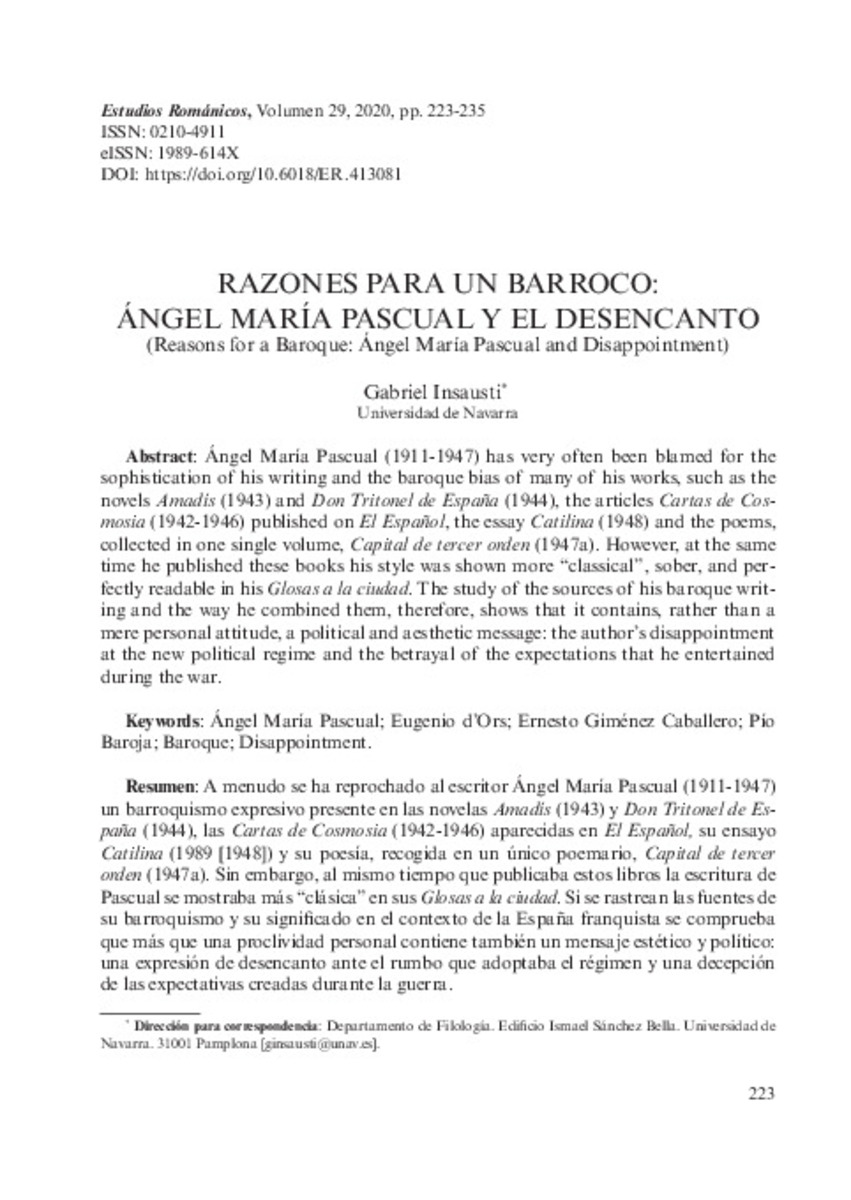Full metadata record
| DC Field | Value | Language |
|---|---|---|
| dc.creator | Insausti, G. (Gabriel) | - |
| dc.date.accessioned | 2023-10-31T08:33:22Z | - |
| dc.date.available | 2023-10-31T08:33:22Z | - |
| dc.date.issued | 2020 | - |
| dc.identifier.citation | Insausti, G. (Gabriel). "Razones para un barroco: Ángel María Pascual y el desencanto". Estudios Romanicos. 29, 2020, 223 - 235 | es |
| dc.identifier.issn | 0210-4911 | - |
| dc.identifier.uri | https://hdl.handle.net/10171/67786 | - |
| dc.description.abstract | A menudo se ha reprochado al escritor Ángel María Pascual (1911-1947) un barroquismo expresivo presente en las novelas Amadís (1943) y Don Tritonel de España (1944), las Cartas de Cosmosia (1942-1946) aparecidas en El Español, su ensayo Catilina (1989 [1948]) y su poesía, recogida en un único poemario, Capital de tercer orden (1947a). Sin embargo, al mismo tiempo que publicaba estos libros la escritura de Pascual se mostraba más “clásica” en sus Glosas a la ciudad. Si se rastrean las fuentes de su barroquismo y su signi!cado en el contexto de la España franquista se comprueba que más que una proclividad personal contiene también un mensaje estético y político: una expresión de desencanto ante el rumbo que adoptaba el régimen y una decepción de las expectativas creadas durante la guerra. | es_ES |
| dc.description.abstract | Ángel María Pascual (1911-1947) has very often been blamed for the sophistication of his writing and the baroque bias of many of his works, such as the novels Amadís (1943) and Don Tritonel de España (1944), the articles Cartas de Cosmosia (1942-1946) published on El Español, the essay Catilina (1948) and the poems, collected in one single volume, Capital de tercer orden (1947a). However, at the same time he published these books his style was shown more “classical”, sober, and perfectly readable in his Glosas a la ciudad. The study of the sources of his baroque writing and the way he combined them, therefore, shows that it contains, rather than a mere personal attitude, a political and aesthetic message: the author’s disappointment at the new political regime and the betrayal of the expectations that he entertained during the war. | es_ES |
| dc.language.iso | spa | es_ES |
| dc.publisher | Universidad de Murcia | es_ES |
| dc.rights | info:eu-repo/semantics/openAccess | es_ES |
| dc.subject | Ángel María Pascual | es_ES |
| dc.subject | Eugenio d’Ors | es_ES |
| dc.subject | Ernesto Giménez Caballero | es_ES |
| dc.subject | Pío Baroja | es_ES |
| dc.subject | Baroque | es_ES |
| dc.subject | Disappointment | es_ES |
| dc.subject | Barroco | es_ES |
| dc.subject | Desencanto | es_ES |
| dc.title | Razones para un barroco: Ángel María Pascual y el desencanto | es_ES |
| dc.title.alternative | Reasons for a baroque: Angel Maria Pascual and disappointment | es_ES |
| dc.type | info:eu-repo/semantics/article | es_ES |
| dc.description.note | Esta obra está bajo una licencia internacional Creative Commons Atribución-NoComercial-CompartirIgual 4.0. | es_ES |
| dc.identifier.doi | 10.6018/ER.413081 | - |
| dadun.citation.endingPage | 235 | es_ES |
| dadun.citation.publicationName | Estudios Romanicos | es_ES |
| dadun.citation.startingPage | 223 | es_ES |
| dadun.citation.volume | 29 | es_ES |
Files in This Item:
Statistics and impact
Items in Dadun are protected by copyright, with all rights reserved, unless otherwise indicated.






